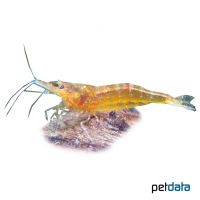Caridina Brevicarpalis (Caridina brevicarpalis)
| Caridina Brevicarpalis Caridina brevicarpalis | |
|---|---|
| Name | Caridina Brevicarpalis |
| Name Lat. | Caridina brevicarpalis |
| Family | Shrimps |
| Family lat. | Atyidae |
| Order | Decapoda |
| Order lat. | Decapoda |
| Origin | Southern Asia |
| Habitat | Streams, estuaries |
| Diet | Omnivore |
| pH | 6.5-8.0 |
| Behavior | Peaceful |
| Keeping | Group |
| Care Level | Moderate |
| Reproduction | Marine larval stages |
| Breeding | Difficult |
| Life Span | 2-3 years |
| Protection | No |
| Metric Units | |
| Size | 3.0-4.0 cm |
| Temperature | 20-28 °C |
| Hardness | 3-30 °dH |
| Aquarium | 50 l |
| US Units | |
| Size | 1.2"-1.4" |
| Temperature | 68-82 °F |
| Hardness | 53-534 ppm |
| Aquarium | 15 gal |
Distribution and habitat
Stick shrimp are widely distributed in the Indo-Pacific region, from Taiwan to Indonesia and Fiji. They live mainly in coastal waters, such as mangrove swamps and in estuaries.
Maintenance
They require an aquarium structured with roots, rocks and coarse debris and a moderately strong current. Planting with Java moss or other small plants is recommended for visual reasons. The substrate of dark sand or fine gravel should be partially covered with foliage (e.g. sea almond leaves, oak leaves), decaying plant material and mulm.
No ammonia, ammonium and nitrite should be detectable in the aquarium water, the nitrate value should not exceed 100 mg/l. To ensure the water quality and oxygen content, a filter and heater adapted to the size of the aquarium is required, as well as lighting for the species-appropriate day-night rhythm of the animals. When choosing the filter, special care should be taken to ensure that the animals cannot be sucked in.
Diet
In nature, they use the bristles of their scissor legs to rasp off growth organisms from stones, dead wood and plants. They can be fed well with autumn leaves of native trees (e.g. oak, beech, maple, birch), sea almond tree leaves as well as fresh, scalded nettle or dandelion leaves, spirulina algae and special shrimp food with low protein content (below 30%), plus spinach, freshly scalded or frozen. It is recommended to coat stones or roots with a slurry of spirulina, chlorella and other algae powder and place them in the aquarium after they have dried. Dry food for fish and crayfish, frozen or freeze-dried food as well as live food such as cyclops, daphnia, Artemia nauplii and microworms should only be offered occasionally due to the high protein content.
It is sufficient to feed them about 3 times a week. Unaccepted food should be siphoned off after about 12 hours. Regular and varied feeding promotes the well-being of the animals.
Behaviour and compatibility
They should be kept in a group of at least 10 animals. Keeping them in a species tank is recommended, but they can also be kept with other Caridina and Neocaridina species as well as with small, peaceful fish in a community tank with lots of moss and fine-feathered plants (hiding places).
Basically, only compatible animals with similar demands on water conditions and water temperature should be socialized.
Reproduction and breeding
Females are significantly larger and have a more curved hind body.
They attach up to 1,000 very small eggs to their swimming legs (pleopods) every 5-6 weeks, which are shed as larvae after a gestation period of about 4 weeks, develop in seawater and then migrate back to the brackish or freshwater of the rivers. Breeding in the aquarium is hardly possible.
Important
The peaceful group animals are conspicuous by their mostly free-swimming locomotion. Their coloration is variable depending on their mood.
The foliage (sea almond tree, oak, beech, etc.) not only provides cover, but when rotting promotes the development of microorganisms, which are a valuable secondary food source
The well-being of the animals should be monitored regularly. Temperature should be checked daily, pH, hardness and nitrate levels at least every 14 days. Regular partial water changes are recommended, even when contaminant levels have not yet reached the upper limit. Sudden changes in water quality should be avoided. Newly introduced animals must be accustomed slowly to the water in the aquarium.
Further literature can be found in your pet store.
References
Text: petdata; Image: petdata
Source: KARGE & KLOTZ (2007): Süßwassergarnelen aus aller Welt, Dähne Verlag; ENGELMANN & LANGE (2011): Zootierhaltung - Tiere in menschlicher Obhut: Wirbellose, Verlag Harri Deutsch
